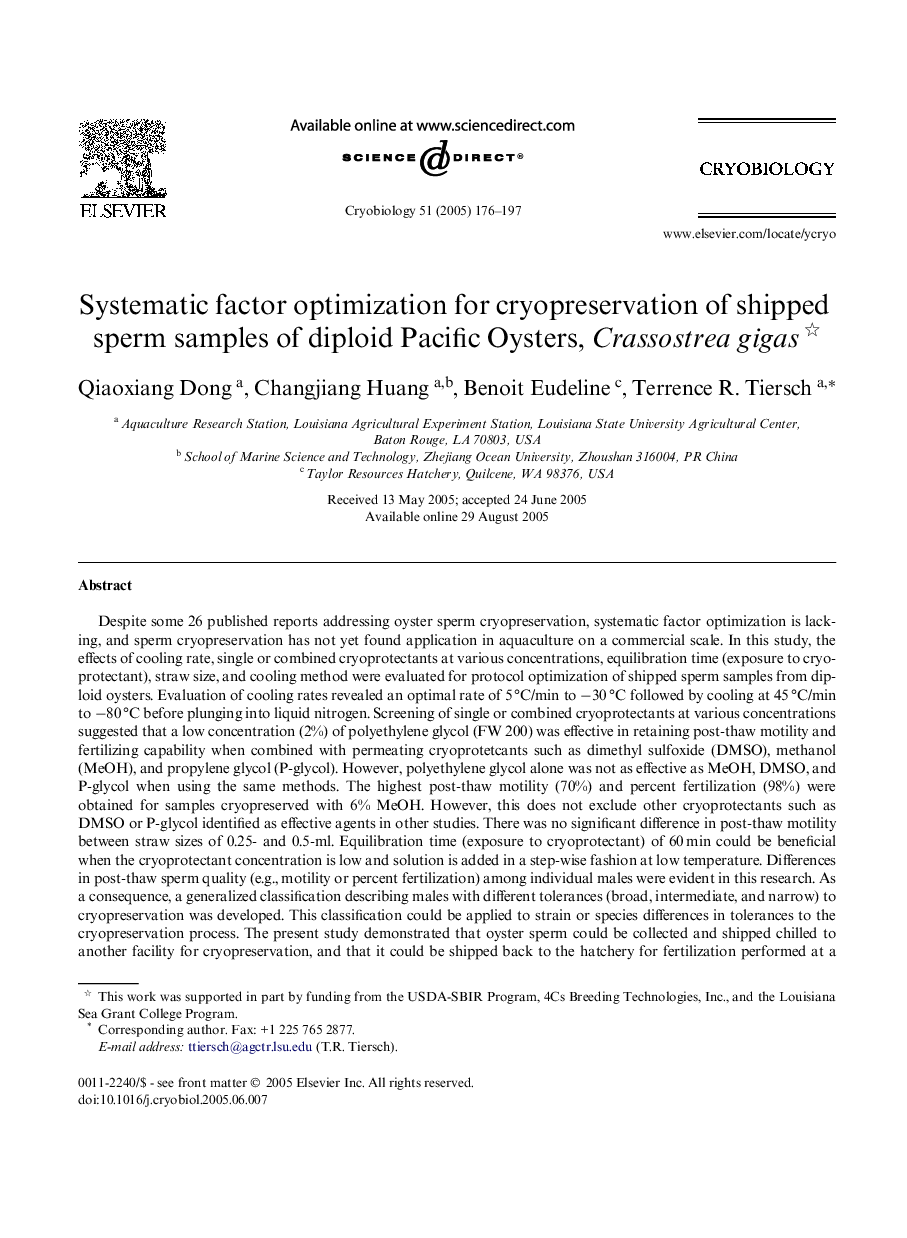| کد مقاله | کد نشریه | سال انتشار | مقاله انگلیسی | نسخه تمام متن |
|---|---|---|---|---|
| 10928626 | 1092935 | 2005 | 22 صفحه PDF | دانلود رایگان |
عنوان انگلیسی مقاله ISI
Systematic factor optimization for cryopreservation of shipped sperm samples of diploid Pacific Oysters, Crassostrea gigas
دانلود مقاله + سفارش ترجمه
دانلود مقاله ISI انگلیسی
رایگان برای ایرانیان
کلمات کلیدی
موضوعات مرتبط
علوم زیستی و بیوفناوری
علوم کشاورزی و بیولوژیک
علوم کشاورزی و بیولوژیک (عمومی)
پیش نمایش صفحه اول مقاله

چکیده انگلیسی
Despite some 26 published reports addressing oyster sperm cryopreservation, systematic factor optimization is lacking, and sperm cryopreservation has not yet found application in aquaculture on a commercial scale. In this study, the effects of cooling rate, single or combined cryoprotectants at various concentrations, equilibration time (exposure to cryoprotectant), straw size, and cooling method were evaluated for protocol optimization of shipped sperm samples from diploid oysters. Evaluation of cooling rates revealed an optimal rate of 5 °C/min to â30 °C followed by cooling at 45 °C/min to â80 °C before plunging into liquid nitrogen. Screening of single or combined cryoprotectants at various concentrations suggested that a low concentration (2%) of polyethylene glycol (FW 200) was effective in retaining post-thaw motility and fertilizing capability when combined with permeating cryoprotetcants such as dimethyl sulfoxide (DMSO), methanol (MeOH), and propylene glycol (P-glycol). However, polyethylene glycol alone was not as effective as MeOH, DMSO, and P-glycol when using the same methods. The highest post-thaw motility (70%) and percent fertilization (98%) were obtained for samples cryopreserved with 6% MeOH. However, this does not exclude other cryoprotectants such as DMSO or P-glycol identified as effective agents in other studies. There was no significant difference in post-thaw motility between straw sizes of 0.25- and 0.5-ml. Equilibration time (exposure to cryoprotectant) of 60 min could be beneficial when the cryoprotectant concentration is low and solution is added in a step-wise fashion at low temperature. Differences in post-thaw sperm quality (e.g., motility or percent fertilization) among individual males were evident in this research. As a consequence, a generalized classification describing males with different tolerances (broad, intermediate, and narrow) to cryopreservation was developed. This classification could be applied to strain or species differences in tolerances to the cryopreservation process. The present study demonstrated that oyster sperm could be collected and shipped chilled to another facility for cryopreservation, and that it could be shipped back to the hatchery for fertilization performed at a production scale yielding live larvae with >90% fertilization. Given the existence of facilities for commercial-scale cryopreservation of dairy bull sperm, the methods developed in the present study for oysters provide a template for the potential commercialization of cryopreserved sperm in aquatic species.
ناشر
Database: Elsevier - ScienceDirect (ساینس دایرکت)
Journal: Cryobiology - Volume 51, Issue 2, October 2005, Pages 176-197
Journal: Cryobiology - Volume 51, Issue 2, October 2005, Pages 176-197
نویسندگان
Qiaoxiang Dong, Changjiang Huang, Benoit Eudeline, Terrence R. Tiersch,